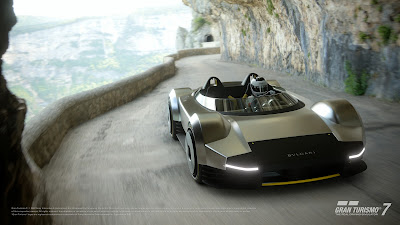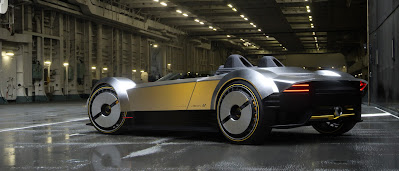Futurecrafted Fantasy - In the ever-evolving world of concept cars, few things capture the imagination quite like a machine that dares to break all the rules. We’ve already seen bold efforts like the Plymouth Prowler, the Volvo T6 Roadster, and the Ford Indigo Concept—vehicles that threw convention out the window and embraced outrageous styling, cutting-edge ideas, and the wild spirit of hot rods and roadsters. But while those models turned heads, Toyota came out with something even more radical—something that looked straight out of a video game and had the futuristic performance to match. Meet the Toyota MTRC Concept.
 |
| Toyota's Motor Triathlon Race Car (MTRC) fuel cell concept made its debut at the 2004 Geneva Motor Show. (Picture from: CarAndDriver) |
Short for Motor Triathlon Race Car, the MTRC wasn’t your typical concept. Created by Toyota’s European Design and Development team in the early 2000s, it was built with one mission in mind: to show the world what Toyota could do when it fully embraced technology, performance, and youthful energy. The result was a car that looked like a junior Formula One racer but was actually designed to dominate three completely different terrains—urban streets, traditional racetracks, and even off-road courses. That’s where the “Triathlon” in its name comes from. It wasn’t just built for one surface, it was meant to handle everything.
 |
| Toyota's Motor Triathlon Race Car (MTRC) fuel cell concept, a car that looked like a junior Formula One racer but was actually designed to dominate three completely different terrains—urban streets, traditional racetracks, and even off-road courses. (Picture from: Car_Daily_Revs) |
From a distance, the MTRC looked like it belonged in a futuristic race film. It had an open-wheel layout, ultra-low profile, and a body that seemed to float above the ground. But the wild design wasn’t just for show. Underneath, Toyota packed in serious innovation. Each of the four wheels was powered by its own electric motor, allowing for full independent control. These motors got their energy from a compact hydrogen fuel cell—yes, the same clean tech that powers the Toyota Mirai today. This meant the MTRC didn’t produce any emissions other than water vapor, giving it green credentials long before sustainability was a buzzword.
 |
| Toyota's Motor Triathlon Race Car (MTRC) fuel cell concept looked like it belonged in a futuristic race film, and had an open-wheel layout, ultra-low profile, and a body that seemed to float above the ground. (Picture from: Car_Daily_Revs) |
What really set the MTRC apart, though, was the driving experience. Instead of a traditional dashboard, the driver wore a “Mixed Reality” helmet that delivered real-time information straight into their view—G-forces, tire temps, road conditions, even predictive feedback based on grip levels and temperature. This wasn’t just about speed; it was about immersive control. The helmet turned driving into something closer to a high-tech simulation, blending real-world performance with digital interactivity in a way that few cars, even now, dare to do.
 |
| The Toyota's Motor Triathlon Race Car (MTRC) concept featured serious innovation, with each wheel driven independently by electric motors powered by a compact hydrogen fuel cell. (Picture from: MotorLegend) |
Toyota was clearly aiming this car at the rising generation of the early 2000s—young people who were hooked on video games, fascinated by mobile tech, and obsessed with the digital world. In fact, many fans first encountered the MTRC not on the road, but in the virtual tracks of Gran Turismo 4, where it was a playable car. And it wasn’t there by accident. Toyota deliberately leaned into that virtual crossover, knowing that the MTRC’s bold look and futuristic tech would resonate most with gamers and young enthusiasts.
 |
| The Toyota's Motor Triathlon Race Car (MTRC) fuel cell concept integrated advanced computing power to ensure all four wheels adapted seamlessly to any terrain. (Picture from: MotorLegend) |
 |
| The Toyota's Motor Triathlon Race Car (MTRC) fuel cell concept integrated advanced computing power to ensure all four wheels adapted seamlessly to any terrain. (Picture from: CarSales) |
Still, for all its innovation, the MTRC was never meant for production. Like many concept cars, it served as a statement more than a sales pitch—a glimpse into what Toyota could do when imagination met engineering. It wasn’t built to sell; it was built to inspire. And it certainly did. You can see echoes of that same spirit in later Toyota creations, such as the Toyota e-Racer concept, which debuted at the 2019 Tokyo Motor Show.
 |
| The Toyota's Motor Triathlon Race Car (MTRC) fuel cell concept featured fully dynamic suspension and grip systems that adjusted in real-time for maximum stability and control, supported by a single-gear direct drive and electric torque at all four corners. (Picture from: Car_Daily_Revs) |
Would it have actually succeeded on the open market? That’s hard to say. The price tag alone, considering all the bleeding-edge tech, might’ve made it inaccessible for most young buyers—the very people it was designed for. And if the lukewarm youth reception to something like the Plymouth Prowler was any indication, perhaps the MTRC was always meant to live in the spotlight of possibility, not practicality.
 Even so, the Toyota MTRC remains one of the most fascinating concept vehicles ever created. Not because it promised to change the roads we drive on, but because it dared to ask: What if the next generation of driving wasn’t just cleaner or faster—but smarter, more immersive, and way more fun? For that reason alone, the MTRC still holds its place among the most unforgettable visions of what cars could be. *** [EKA | FROM VARIOUS SOURCES | TOYOTA | DISENO-ART | TOPGEAR | CARBUZZ | CARANDDRIVER | CAR_DAILY_REVS | MOTORLEGEND | CARSALES.COM.AU ]
Even so, the Toyota MTRC remains one of the most fascinating concept vehicles ever created. Not because it promised to change the roads we drive on, but because it dared to ask: What if the next generation of driving wasn’t just cleaner or faster—but smarter, more immersive, and way more fun? For that reason alone, the MTRC still holds its place among the most unforgettable visions of what cars could be. *** [EKA | FROM VARIOUS SOURCES | TOYOTA | DISENO-ART | TOPGEAR | CARBUZZ | CARANDDRIVER | CAR_DAILY_REVS | MOTORLEGEND | CARSALES.COM.AU ]Note: This blog can be accessed via your smart phone.











































